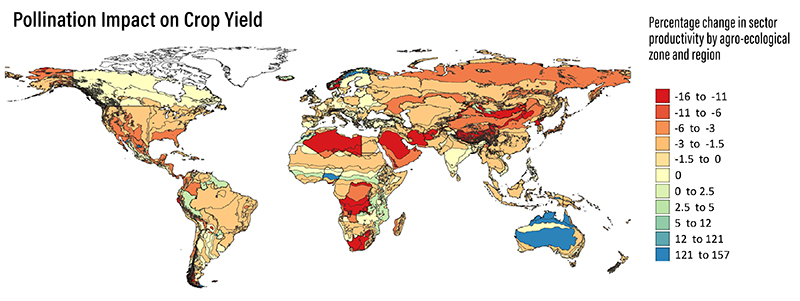Analysis shows how investing in nature improves the economy while boosting equity
Research combines global economic model with ecosystem benefit models
Current trends in environmental degradation will lead to large economic losses in the coming decades, hitting the poorest countries hardest, according to a new study led by Purdue University and the University of Minnesota. The study also finds that investing in nature can turn those losses into gains.
The findings, published in Proceedings of the National Academy of Sciences, develop a novel, global Earth-economy model to capture interactions between the economy and the environment. Crucially, these interactions include how nature benefits humans by pollinating crops, providing timber, storing carbon and providing catch for marine fisheries, and how those benefits affect the economy overall.
“Traditional economic models almost completely neglect the fact that the economy relies on nature,” said study co-author Thomas Hertel, Distinguished Professor of Agricultural Economics at Purdue. “This new study required a detailed understanding of how and where land use patterns change as a result of economic activity, with enough spatial detail to understand the environmental consequences of these changes.”
The study was led by Justin Johnson of the University of Minnesota. Along with Hertel, co-authors include Purdue’s Uris Lantz Baldos and Erwin Corong, both of the Center for Global Trade Analysis, as well as Steve Polasky, co-leader of Global to Local Analysis of Systems Sustainability (GLASSNET), and other collaborators at the University of Minnesota, the World Bank and Canada’s University of Victoria.
The researchers combined multiple models to achieve their results. One was Purdue’s Global Trade Analysis Project (GTAP) model, which performs quantitative analyses on a wide range of interconnected international economic issues.
The other suite of models, called Integrated Valuation of Ecosystem Services and Tradeoffs (InVEST), was developed at Stanford University’s Natural Capital Project. GTAP and InVEST are both widely used globally by government policymakers, nongovernmental organizations and the private sector.
“We have long thought of the economy and the environment as working against each other,” said the study’s lead author, Johnson, assistant professor of applied economics at the University of Minnesota. “Investing in nature does not stifle the economy; it boosts the economy. But it has been difficult to model those interactions until recently.”
Hertel founded GTAP 30 years ago. GTAP has since grown into a global network of 26,000 members who contribute data and expertise from 160 countries and regions. Purdue’s GTAP economists assemble and connect the data to various modeling frameworks. Economic flows are categorized into 65 sectors: 20 in agriculture and food, 25 in manufacturing, and 20 in services.
“The database now covers 98% of global gross domestic product in great detail,” Hertel said. And the database links agriculture and many other aspects of national and global economies. “That’s important for the kind of study we have here,” he said.
The integrated GTAP-InVEST model expands upon similar policy-related work published by the World Wildlife Fund in 2020 and the World Bank in 2021.
“We hope to make this kind of analysis a standard tool in a policymaker’s toolbox,” Johnson said.
The new study examined policy options for investing in nature, including removing agricultural subsidies, financing research into improving crop yields, and international payments for wealthy countries to poorer countries to support conservation. The policies resulted in annual gains of $100 million to $350 million in 2014 U.S. dollars. The largest percentage increases in GDP occurred in low-income countries.
Continued trends in environmental degradation, by contrast, would result in $75 billion in losses annually. This included low-income countries suffering 0.2% losses in GDP every year. These results highlight how public goods and services provided by the environment are often the most important for the world’s poorest, who have less access to alternative options in a degrading environment. Investing in nature thus tends to make the world more equitable, the researchers said.
The study was funded by Purdue, the University of Minnesota and the National Science Foundation and exemplifies what the two universities strive to achieve in their GLASSNET project. The Purdue-based GLASSNET is an international network of networks devoted to sustainability analysis.
“One theme behind GLASSNET is this idea of global to local to global,” Hertel said. “It’s bridging the global with the local because all sustainability issues are ultimately very local.”
If pollinating insects, for example, can no longer reach crops in certain areas, reduced yields result. That, in turn, reduces profits, showing the link between nature and the economy, Hertel said.
The new research looked at only a small subset of the ways that the economy and the environment interact, yet still found strikingly large effects. Hertel and his colleagues expect an entire line of research to continue developing along these lines.
“We would like to broaden GLASSNET coverage of ecosystem services,” he said. “There are many important services nature provides that aren’t quantified here – groundwater, for example. There’s a lot more to be done.”







